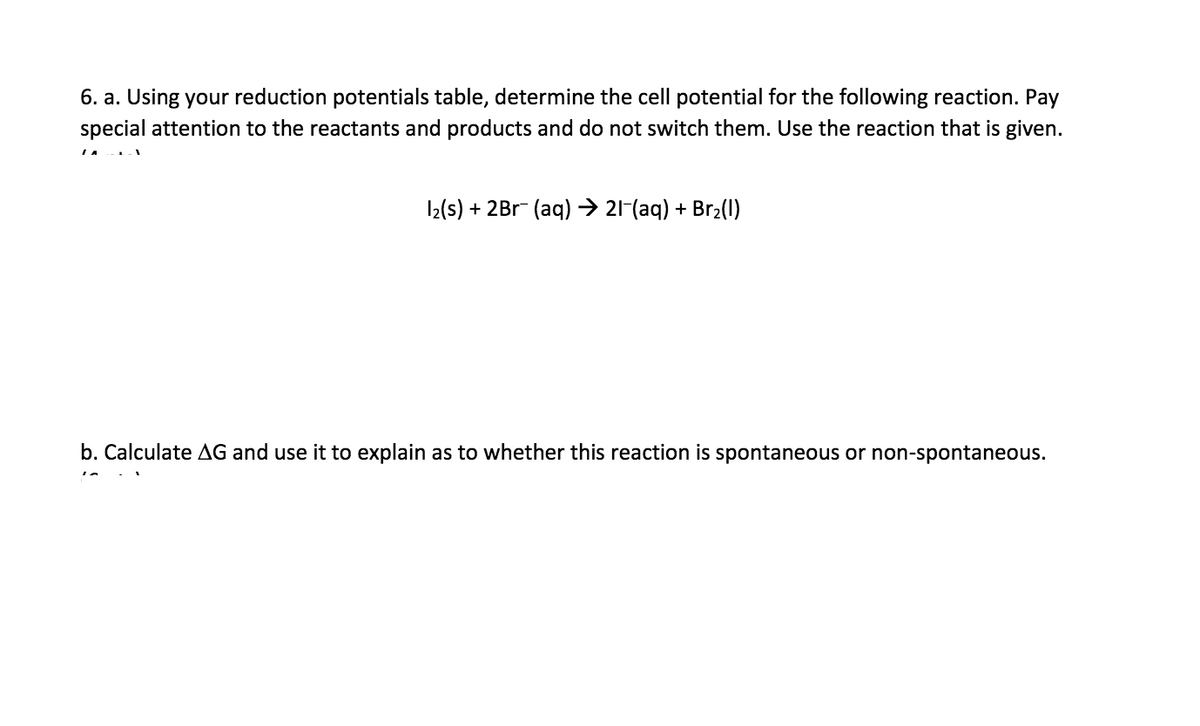6. a. Using your reduction potentials table, determine the cell potential for the following reaction. Pay special attention to the reactants and products and do not switch them. Use the reaction that is given. 12(s) + 2Br- (aq) → 21(aq) + Br2(1) b. Calculate AG and use it to explain as to whether this reaction is spontaneous or non-spontaneous.
6. a. Using your reduction potentials table, determine the cell potential for the following reaction. Pay special attention to the reactants and products and do not switch them. Use the reaction that is given. 12(s) + 2Br- (aq) → 21(aq) + Br2(1) b. Calculate AG and use it to explain as to whether this reaction is spontaneous or non-spontaneous.
Chemistry: Principles and Practice
3rd Edition
ISBN:9780534420123
Author:Daniel L. Reger, Scott R. Goode, David W. Ball, Edward Mercer
Publisher:Daniel L. Reger, Scott R. Goode, David W. Ball, Edward Mercer
Chapter18: Electrochemistry
Section: Chapter Questions
Problem 18.44QE: For each of the reactions, calculate E from the table of standard potentials, and state whether the...
Related questions
Question
Using your reduction potentials table, determine the cell potential for the following reaction. Pay special attention to the reactants and products and do not switch them. Use the reaction that is given.
I2(s) + 2Br−(aq) →2I−(aq) + Br2(l

Transcribed Image Text:6. a. Using your reduction potentials table, determine the cell potential for the following reaction. Pay
special attention to the reactants and products and do not switch them. Use the reaction that is given.
I2(s) + 2Br (aq) → 21-(aq) + Br2(1)
b. Calculate AG and use it to explain as to whether this reaction is spontaneous or non-spontaneous.
Expert Solution
This question has been solved!
Explore an expertly crafted, step-by-step solution for a thorough understanding of key concepts.
Step by step
Solved in 3 steps

Knowledge Booster
Learn more about
Need a deep-dive on the concept behind this application? Look no further. Learn more about this topic, chemistry and related others by exploring similar questions and additional content below.Recommended textbooks for you

Chemistry: Principles and Practice
Chemistry
ISBN:
9780534420123
Author:
Daniel L. Reger, Scott R. Goode, David W. Ball, Edward Mercer
Publisher:
Cengage Learning


Chemistry: An Atoms First Approach
Chemistry
ISBN:
9781305079243
Author:
Steven S. Zumdahl, Susan A. Zumdahl
Publisher:
Cengage Learning

Chemistry: Principles and Practice
Chemistry
ISBN:
9780534420123
Author:
Daniel L. Reger, Scott R. Goode, David W. Ball, Edward Mercer
Publisher:
Cengage Learning


Chemistry: An Atoms First Approach
Chemistry
ISBN:
9781305079243
Author:
Steven S. Zumdahl, Susan A. Zumdahl
Publisher:
Cengage Learning

Chemistry
Chemistry
ISBN:
9781305957404
Author:
Steven S. Zumdahl, Susan A. Zumdahl, Donald J. DeCoste
Publisher:
Cengage Learning

Principles of Modern Chemistry
Chemistry
ISBN:
9781305079113
Author:
David W. Oxtoby, H. Pat Gillis, Laurie J. Butler
Publisher:
Cengage Learning

Chemistry: The Molecular Science
Chemistry
ISBN:
9781285199047
Author:
John W. Moore, Conrad L. Stanitski
Publisher:
Cengage Learning